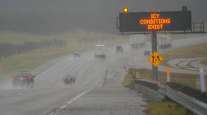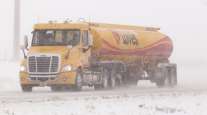Special to Transport Topics
Snow Removal Systems Save Time, Boost Safety for Fleets
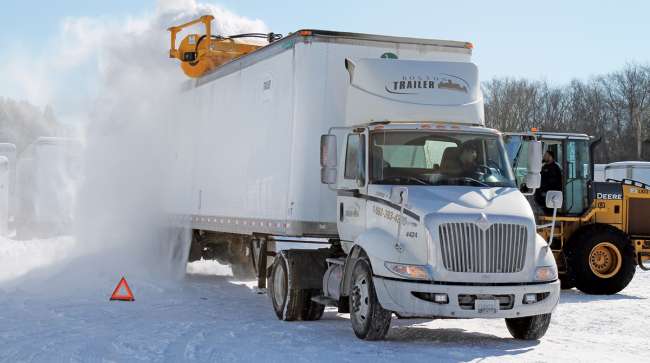
[Stay on top of transportation news: Get TTNews in your inbox.]
One wintry day several years ago, Fleet Services by Cox Automotive was driving a truck to a customer when a 6-foot chunk of ice slipped off of the trailer and hit a car that was following the vehicle.
Thankfully, no one was injured, “but it was a wake-up call for us,” said Kurt Gustafson, general manager for Fleet Services. The fleet maintenance provider subsequently decided to invest in snow removal technology at two of its three facilities in New York, a state that levies fines on companies that do not remove snow from the roofs of their trailers.
Indeed, more trucking firms are joining Fleet Services in buying or renting automotive snow removal equipment to not only quicken the time it takes to remove snow but also to ensure that trucks are conducting safe operations in winter. Complying with state regulations on clearing the snow off of trailer roofs is another motivator.
“More and more distribution centers are realizing the importance of having this technology on-site to comply with state regulations, eliminating those potential fines,” said Joe Cosenza, senior field safety manager for CPC Logistics. “They are also realizing the importance of this technology for the safety of their on-site personnel, the drivers operating their equipment and the safety of the public.”
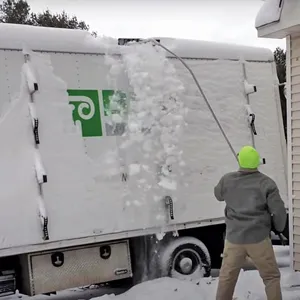
Manually removing snow and ice from trucks and trailers can be a time-consuming and labor-intensive process for workers. (CPC Logistics)
The most common snow removal devices on the market seem to be snow scraper systems, but there are other options such as systems using high-speed air turbulence to blow the snow off of trailer roofs, Cosenza said.
Fleets seeking snow removal technology must consider factors such as multi-height equipment and yard space constraints, said Debora Babin Katz, vice president of TrucBrush, a company that manufactures a large, mobile brush to remove snow from trailers.
Addressing icy debris is another concern, she added.
“The last few years in the U.S., the snow accumulation has had an uptick of icy debris caused by switchback of rain, sleet and snow, so the chances for bonded ice formation on the tops of trucks, trailers and flatbeds is even higher,” Katz said. “[Companies] want to make sure they invest in technology which can handle this type of debris, and I see that trend continuing as Mother Nature continues to bring those types of storms our way.”
Machine-based snow removal systems can significantly reduce the time required to clear snow from trucking equipment while also improving worker safety and productivity.
Host Seth Clevenger and Features Coordinator Mike Senatore take you behind the scenes to unveil the 2024 Top 50 Global Freight Companies. Tune in above or by going to RoadSigns.ttnews.com.
Manually removing snow might take 10 to 20 minutes for a tractor cab and as long as an hour for a trailer, which typically would involve a driver or another employee climbing to the roof of the trailer to shovel off the snow, Cosenza said.
Overhead snow removal structures can handle that task much faster. The most time-consuming part of the scraper process becomes removing the mounds of snow left on the ground, he said.
At Fleet Services, it now usually takes under 10 minutes to scrape away snow or ice from a truck or trailer, although the time may vary depending on the vehicle and the amount and type of snow.
Before the snow removal system, it could take workers anywhere between 30 to 60 minutes to remove snow manually with shovels, according to Gustafson. It was also “extremely unsafe,” he added.
Katz says it takes about 30 seconds to clear accumulated snow from a truck rooftop using the mobile TrucBrush attachment. To address snow accumulation on the ground after it’s been brushed off a truck, TrucBrush has been designed to clear snow off to a designated area away from the travel lane.
Want more news? Listen to today's daily briefing above or go here for more info
TrucBrush invented its product after a large freight forwarding facility’s regional manager set out to find a safer, faster and more effective way to remove snow accumulation without damaging vehicles’ rooftops or taking up too much space in the yard.
As a result of that request, TrucBrush created a rotary, all-weather, polypropylene-bristled broom to help solve the industry’s snow removal problem.
“There’s an old English proverb: ‘Necessity is the mother of invention,’ and that holds very true in the case of TrucBrush,” Katz said.
When companies are finished using the machine, it can be stored elsewhere in the yard to make space for fleet traffic, she said.
A second model, TrucBrush SD-19, brushes snow off flatbeds with step decks and lowboys in addition to truck and trailer rooftops.
The company sells and rents TrucBrush to companies of all sizes, from fleets of 15 trucks to thousands of tractor-trailers. Commercial snow contractors also purchase or rent the equipment at their snow management facilities, which may offer the use of TrucBrush to trucking companies.
Meanwhile, two of Fleet Services' New York facilities use a snow removal system manufactured by Scraper Systems, a Lancaster, Pa.-based subsidiary of Rite-Hite.
Gustafson described the snow removal system as a tall H-frame made out of steel, with a big broom on top and a rubber flap on the bottom. The broom can be raised or lowered to adjust to a vehicle’s height, and the vehicle drives through the frame.
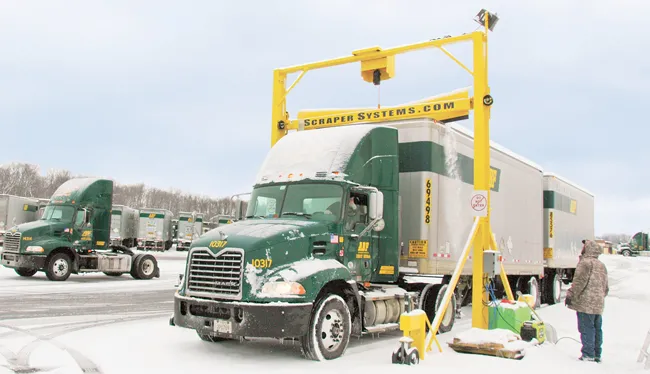
Some fleets have installed drive-through scrapers to remove snow from the tops of trailers. (Scraper Systems)
It requires very little maintenance, according to Gustafson. The only repairs in the last five years have been to address minor wiring issues.
Nonetheless, maintaining the snow removal system should be a priority for companies, according to CPC Logistics’ Cosenza, as neglecting maintenance could lead to reduced performance and increased downtime.
“Regular care and maintenance not only extend the lifespan of the equipment but also enhances its efficiency and reliability during critical snow removal operations,” Cosenza said.
Efficiency, Safety and Compliance
Companies using snow removal systems cite benefits including worker safety, operational efficiency and improved compliance with state snow removal regulations.
“From a safety perspective, this equipment has been worth the investment,” Cosenza said. “The snow removal system has helped reduce injury exposure from slips, falls, muscle strains and back injuries to even heart attacks.”
Cosenza also said CPC Logistics’ drivers “speak highly” of the snow scraper for saving time and giving drivers peace of mind about snow and ice not falling from their trailers while traveling down the roadway.
Gustafson agreed, saying that snow removal systems have reduced delays and turnaround times, as well as reduced or eliminated fines for having snow on the truck roof.
Fines for failing to remove snow from vehicles range from $250 to $1,500, depending on the state and repeat violations. Regions with existing or pending regulations include New England, the Midwest, the Mid-Atlantic and western and northern states.
Fines for failing to remove snow from vehicles traveling on roadways can range anywhere from $250 to $1,500, depending on the state and repeat violations. Regions that have existing or pending regulations on removing snow from trucks include New England, the Midwest, the Mid-Atlantic and western and northern states.
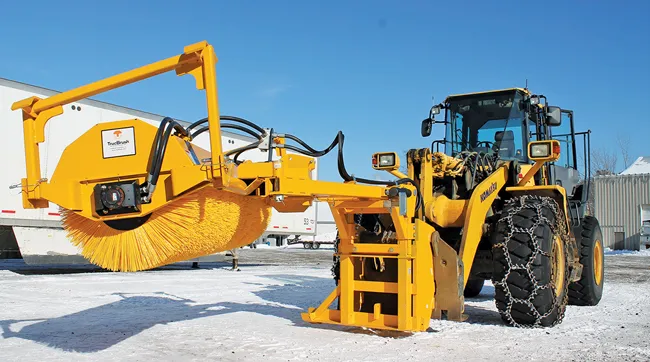
TrucBrush offers products designed to remove snow from trucks and multiple trailer types without damaging the equipment. (TrucBrush)
Chunks of snow or ice falling off a commercial vehicle can be quite large and create safety hazards, while snow blowing off a trailer’s roof can reduce visibility for motorists driving behind the truck.
As companies mull buying or renting snow removal systems, Gustafson said the main issue is their available yard space. That factor could determine whether a company should invest in a portable or stationary system, for example.
Fleet Services has discovered several additional benefits from clearing snow thoroughly from trailer roofs.
Snow removal makes Fleet Services' shop safer in winter by reducing water runoff from melting snow on the shop floor, according to Gustafson.
At the same time, other transportation companies that have noticed Fleet Services' snow removal systems have been willing to pay a fee to use the technology on their own trucks.
“We kind of turned it into something that could create a revenue stream for us,” Gustafson said. “It’s not like we’re making a ton of money, but it is kind of a side benefit that came up that we hadn’t even thought about.”
Gustafson envisions more fleets implementing snow scrapers into their winter operations.
“I think it is a no-brainer for the most important reasons: safety and efficient operations,” he said.



